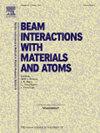Y2O3 and Y2Ti2O7 nanoparticles stability in oxide dispersion strengthened steels under hydrogen irradiation at elevated temperature
IF 1.4
3区 物理与天体物理
Q3 INSTRUMENTS & INSTRUMENTATION
Nuclear Instruments & Methods in Physics Research Section B-beam Interactions With Materials and Atoms
Pub Date : 2025-05-14
DOI:10.1016/j.nimb.2025.165741
引用次数: 0
Abstract
Oxide dispersion-strengthened steels with Y2O3 and Y2Ti2O7 nanoparticles (NPs) and Chinese low-activation ferritic/martensitic steel (CLF) samples were fabricated by the mechanical alloying method and sequentially irradiated at 550 °C with 50 keV H2+ ions to various fluences. The hydrogen-bubble density and average bubble size are significantly higher in CLF steel. After irradiation, the size of NPs in YTO and YO steel reduced to ∼ 7 nm and ∼ 15 nm; finer NPs in YTO steel enhanced the resistance to the irradiation-induced defects. The absence of NPs in CLF causes the formation of dislocation networks. Y2Ti2O7 NPs phases in YTO steel are highly stable and show semi-coherent orientation, while YAlO3 NPs phases show incoherent orientation with the matrix. Y2Ti2O7 NPs resist defect formation by reducing the internal stresses and obstructing dislocation networks. This study suggests that introducing Y2Ti2O7 NP into ODS steel presents a promising approach to improving the resistance towards irradiation damage.
高温氢辐照下氧化分散强化钢中Y2O3和Y2Ti2O7纳米颗粒的稳定性
采用机械合金化方法制备了Y2O3和Y2Ti2O7纳米颗粒(NPs)和中国低活化铁素体/马氏体钢(CLF)样品的氧化物分散强化钢,并在550℃下用50 keV的H2+离子进行了不同程度的辐照。CLF钢的氢泡密度和平均气泡尺寸显著增大。辐照后,YTO和YO钢中NPs的大小分别减小到~ 7 nm和~ 15 nm;YTO钢中较细的NPs增强了其抗辐照缺陷的能力。CLF中NPs的缺失导致位错网络的形成。YTO钢中Y2Ti2O7 NPs相具有较高的稳定性和半共格取向,而YAlO3 NPs相与基体呈非共格取向。Y2Ti2O7 NPs通过减小内应力和阻挡位错网络来抵抗缺陷的形成。该研究表明,在ODS钢中引入Y2Ti2O7 NP是提高ODS钢抗辐照损伤能力的有效途径。
本文章由计算机程序翻译,如有差异,请以英文原文为准。
求助全文
约1分钟内获得全文
求助全文
来源期刊
CiteScore
2.80
自引率
7.70%
发文量
231
审稿时长
1.9 months
期刊介绍:
Section B of Nuclear Instruments and Methods in Physics Research covers all aspects of the interaction of energetic beams with atoms, molecules and aggregate forms of matter. This includes ion beam analysis and ion beam modification of materials as well as basic data of importance for these studies. Topics of general interest include: atomic collisions in solids, particle channelling, all aspects of collision cascades, the modification of materials by energetic beams, ion implantation, irradiation - induced changes in materials, the physics and chemistry of beam interactions and the analysis of materials by all forms of energetic radiation. Modification by ion, laser and electron beams for the study of electronic materials, metals, ceramics, insulators, polymers and other important and new materials systems are included. Related studies, such as the application of ion beam analysis to biological, archaeological and geological samples as well as applications to solve problems in planetary science are also welcome. Energetic beams of interest include atomic and molecular ions, neutrons, positrons and muons, plasmas directed at surfaces, electron and photon beams, including laser treated surfaces and studies of solids by photon radiation from rotating anodes, synchrotrons, etc. In addition, the interaction between various forms of radiation and radiation-induced deposition processes are relevant.

 求助内容:
求助内容: 应助结果提醒方式:
应助结果提醒方式:


